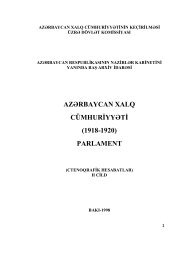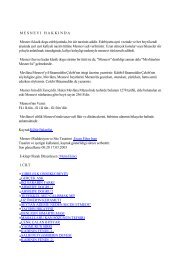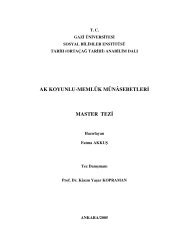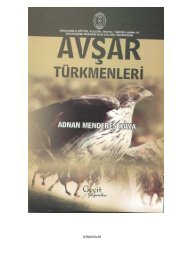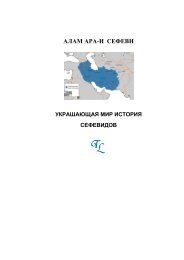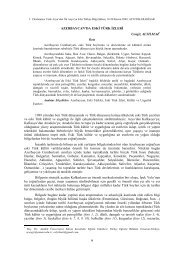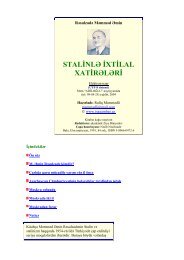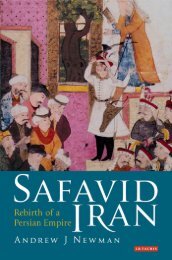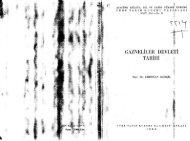War and Peace in Qajar Persia: Implications Past and ... - Oguzlar.az
War and Peace in Qajar Persia: Implications Past and ... - Oguzlar.az
War and Peace in Qajar Persia: Implications Past and ... - Oguzlar.az
- No tags were found...
Create successful ePaper yourself
Turn your PDF publications into a flip-book with our unique Google optimized e-Paper software.
Introduction 7city states, is a situation strik<strong>in</strong>gly rem<strong>in</strong>iscent of the region’s tumult today,a zone of lawlessness <strong>in</strong> which local populations <strong>in</strong> the midst of war havelittle <strong>in</strong>centive to compromize with any of the far-off centres of authority.The concept of a border as a demarcated l<strong>in</strong>e between nations (thus representativeof differently affiliated peoples), <strong>and</strong> which was imposed by externalpowers, is taken up by K<strong>in</strong>g’s College geographer Richard Schofield. In hischapter, “Narrow<strong>in</strong>g the frontier: mid-n<strong>in</strong>eteenth-century efforts to delimit,map <strong>and</strong> demarcate the Perso-Ottoman border”, he describes the tortuousprocess, fraught with <strong>in</strong>trigue, improbity <strong>and</strong> foreign schemes, that was <strong>in</strong>volved<strong>in</strong> draw<strong>in</strong>g the boundary between what are present-day Iran <strong>and</strong> Iraq – anundertak<strong>in</strong>g that was repeated by other border commissions organized byboth the British <strong>and</strong> Russians <strong>in</strong> <strong>Persia</strong>’s southeast as well as northeast. Ineffect, the 1847 Treaty of Erzurum, drawn up between <strong>Persia</strong> <strong>and</strong> Turkey,del<strong>in</strong>eated the Middle East’s first real negotiated border; <strong>in</strong> this, the Ottomans“expressly recognized that the anchorage of Mohammerah <strong>and</strong> the l<strong>and</strong>s eastof the Shatt al-Arab belong<strong>in</strong>g to <strong>Persia</strong>n tribes were <strong>Persia</strong>n territory”. 1Although, like most of the other borders established by negotiation <strong>and</strong> thework of commissions, the process took years, be<strong>in</strong>g subject to dispute <strong>and</strong>renegotiation <strong>in</strong> all cases. However, the process which evolved was to marka significant milestone <strong>in</strong> the establishment of suzera<strong>in</strong>ty over territory <strong>in</strong> theMiddle East, <strong>and</strong> the reversal of the role of war <strong>and</strong> peace <strong>in</strong> establish<strong>in</strong>g it.Strict borders, l<strong>in</strong>es upon a page, as Schofield observes, were a European,not a Middle Eastern, concept. Previously, the boundaries of <strong>Persia</strong>, <strong>in</strong> thesame way as the other states <strong>in</strong> the region, were <strong>in</strong> fact “borderl<strong>and</strong>s”, dozens,if not hundreds, of miles wide, areas of fluctuat<strong>in</strong>g patronage <strong>and</strong> liege thatdid not themselves <strong>in</strong>volve the same suspicion <strong>and</strong> conflict between adjacentpowers that arose once strict l<strong>in</strong>es were drawn <strong>in</strong> the s<strong>and</strong>. The impositionof marked boundaries by Brita<strong>in</strong> <strong>and</strong> Russia upon the <strong>Persia</strong>n <strong>and</strong> Ottomanrulers was therefore a European project for European purposes (even thoughthey never succeeded <strong>in</strong> gett<strong>in</strong>g the l<strong>in</strong>es as perfectly settled as they had wished),<strong>and</strong> had the unexpected result of caus<strong>in</strong>g border friction between <strong>Persia</strong> <strong>and</strong>her neighbours where previously there had been none. Because of its criticalgeopolitical position, <strong>Persia</strong> became the first country <strong>in</strong> the Muslim worldwhose borders were so def<strong>in</strong>ed; North Africa would have its borders del<strong>in</strong>eatedonly later <strong>in</strong> the n<strong>in</strong>eteenth century; the Gulf states <strong>and</strong> the rest of the MiddleEast would not have their borders ruled until post-World <strong>War</strong> I.Even so, Schofield describes a process that was neither efficient nor def<strong>in</strong>itive.After many years of negotiation, the western border of Iran rema<strong>in</strong>ed fungible<strong>and</strong> open to dispute, a fact that cont<strong>in</strong>ues to bedevil its relations withIraq <strong>in</strong>, for example, the Shatt-al Arab <strong>and</strong> the marsh areas to its north, <strong>and</strong>which renders the mathematical accuracy of today’s Global Position<strong>in</strong>gSystem largely irrelevant.More successful was <strong>Persia</strong>’s own extension of <strong>in</strong>disputable dom<strong>in</strong>ion overthe coastl<strong>in</strong>e of the <strong>Persia</strong>n Gulf, a process which was a direct result of theextension of centralized power outwards from Tehran. With the <strong>in</strong>centive of



